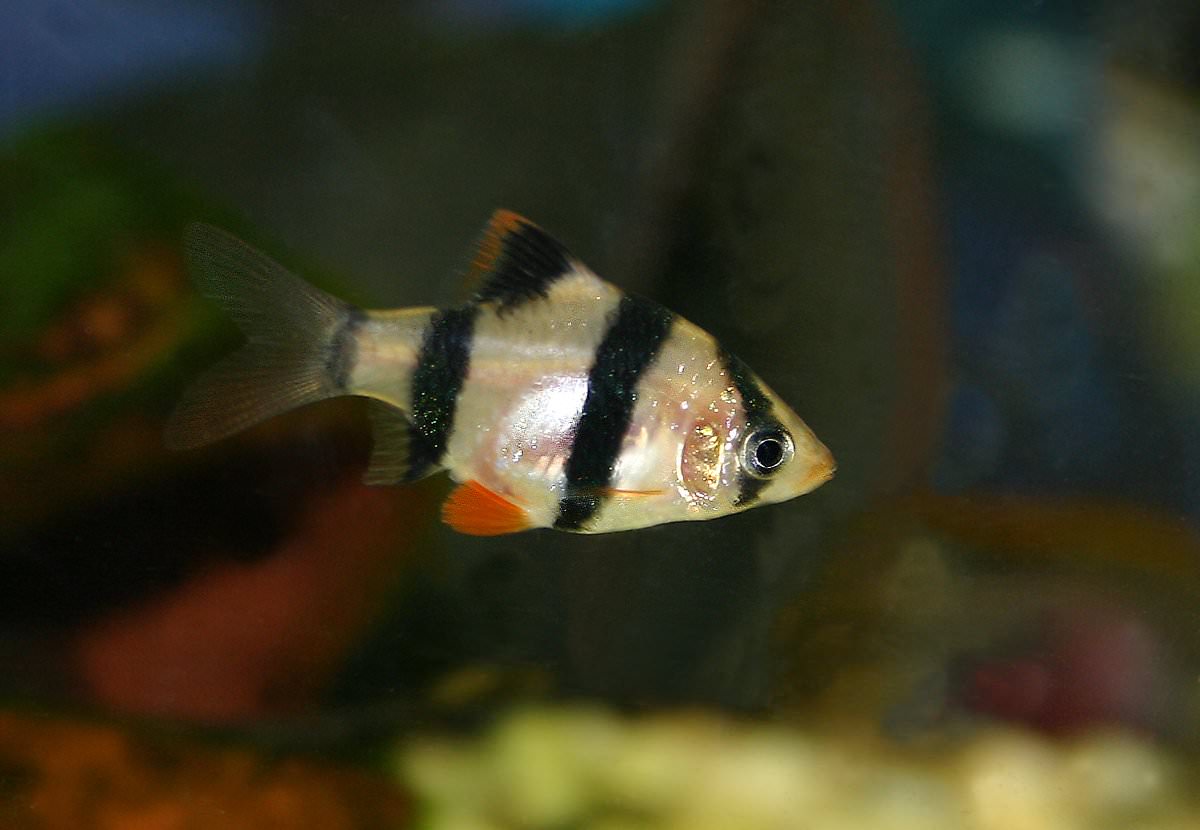The Tiger Barb is a freshwater fish that is native to Southeast Asia. They are a very hardy fish and can live in a variety of different water conditions.
Tiger Barbs are known for being fin nippers and can be aggressive towards other fish. They are also known to be jumpers, so it is important to have a tight fitting lid on your aquarium.
Tiger Barbs are a very active fish and do best in a tank with plenty of hiding spots and places to explore. They are a relatively easy fish to care for and make a great addition to any freshwater aquarium.
Table of contents
Species overview
Tiger barbs (Puntius tetrazona) are a freshwater fish that is native to Southeast Asia, specifically Indonesia, Thailand, and Malaysia.
They are a schooling fish that prefers to live in groups of 6 or more. In the wild, they can be found in slow-moving rivers and streams with plenty of vegetation.
Tiger barbs are omnivores and will eat a variety of foods, including pellets, flakes, live food, and frozen food.
These fish are known for being very active and playful. They are also known to be nippy, so it is important to choose tank mates carefully.
Tiger barbs are a very popular fish for beginner aquarists and experienced aquarists alike. They are relatively easy to care for and are very enjoyable to watch.
Appearance

The tiger barb is a freshwater fish that is easily recognizable due to its stripes. These vertical stripes are a light brown or gold color against a dark brown or black background.
The number of stripes can vary from fish to fish, but most have between 4 and 6. The stripes are thickest near the middle of the body and get thinner towards the fins.
The fins on a tiger barb are fairly standard for a small freshwater fish. The dorsal fin is short and begins about two-thirds of the way back on the body.
The anal fin is a bit shorter and starts closer to the middle of the body as well. Both of these fins are slightly transparent.
The caudal fin is forked and symmetrical. The pectoral fins are thin and relatively short.
Tiger barbs have a long and thin body shape that is similar to other barbs. This gives them a sleek and hydrodynamic appearance that helps them swim quickly.
Lifespan
The average lifespan of a tiger barb is 5 to 7 years. As with any fish, there are a number of factors that can impact their life expectancy.
One thing to keep in mind is that these fish are known to be rather nippy. This means they’re often kept in schools which can lead to a lot of aggression.
This aggression can lead to stress which will shorten their lifespan. In addition, these fish are known to be jumpers so a secure lid is a must.
Size
The maximum size of a tiger barb is about 4 inches in length when fully grown. It’s not uncommon for these fish to stop growing at 2 inches depending on their level of care and genetic factors.
Tank
Tank Size
The minimum tank size for tiger barbs is 30 gallons. If you want to keep a school of tiger barbs, we recommend a tank size of 50 gallons or more.
Tiger barbs are a schooling fish, which means they do best when kept in groups of 6 or more fish. A larger tank will allow you to keep a bigger school, which will make your fish happier and less likely to nip at each other.
Water Parameters
The tiger barb is a freshwater fish that is native to Southeast Asia. In the wild, they are found in slow-moving rivers and streams with plenty of vegetation.
This is a schooling fish, so it’s best to keep them in a group of at least six. They are known to be nippy, so it’s best to keep them with fish that are too large to fit in their mouths.
Tiger barbs are relatively easy to care for and are a good choice for beginner aquarium enthusiasts. Here are a few things to keep in mind when it comes to their water parameters.
- Water temperature: 72 to 82 degrees Fahrenheit
- pH levels: 6.5 to 7.5
- Water hardness: 5 to 19 dGH
- Alkalinity Levels: 3-10 dKH
What To Put In Their Tank
As with most freshwater fish, there are a few key things you need to include in a Tiger Barb tank in order to make sure they’re comfortable and have everything they need.
The first is a good quality gravel substrate. This will help to keep the water clean and provide a place for the plants to root.
You’ll also need to include some plants in their habitat. Tiger Barbs are known to be fin nippers, but there are some varieties that are more resistant to this (like Java Fern or Anubias).
It’s a good idea to have a mix of both floating and rooted plants in their tank. The floating plants will provide them with some cover from the light and the rooted plants will help to keep the water clean.
You’ll also need to include some driftwood or rocks in their tank. These can provide them with hiding places and help to break up the line of sight.
Avoid using anything that’s too small though. Tiger Barbs are known to nibble on things and you don’t want them swallowing anything they shouldn’t.
Common Diseases
There are a few diseases that are relatively common in tiger barbs. The most common is probably ich, which presents itself as white spots on the body and fins of the fish.
Other potential diseases include fin rot, which can cause the fins to become ragged and torn, and gill flukes, which can cause gill irritation and difficulty breathing.
Fortunately, these diseases are relatively easy to treat if you catch them early. The best way to prevent them is to maintain clean and stable water conditions in the tank.
Behavior & Temperament
The tiger barb is a schooling fish, so it’s best kept in groups of five or more. When they’re in a group, they’re relatively peaceful. But when they’re kept in smaller numbers, they can become aggressive and territorial.
This fish is also known to be a fin nipper. So, if you’re keeping them with other fish, make sure they’re a similar size. Otherwise, the tiger barb may try to take bites out of the other fish’s fins.
Tiger barbs are active fish that enjoy swimming around the tank. They’re not shy, so you’ll often see them out in the open. They’re also not afraid to go after food, so don’t be surprised if they snatch food away from other fish in the tank!
Tank Mates
There are a few things to consider when choosing tank mates for tiger barbs.
First, these fish are semi-aggressive. They’re not the most aggressive freshwater fish out there, but they can hold their own in a fight.
As a result, you need to be careful about adding smaller fish to the tank. The tiger barbs might see them as food.
Secondly, tiger barbs like to swim in groups. They’re not a schooling fish, but they do prefer to be in the company of their own kind.
Ideally, you should aim for a ratio of two tiger barbs for every one of their tank mates. This will help reduce their aggression levels and make them feel more comfortable.
Some compatible tank mates for tiger barbs include:
- Tetras
- Guppies
- Mollies
- Platies
- Swordtails
- Rainbows
- Danios
Breeding
Tiger barbs are a popular freshwater fish that are known for their striking orange and black stripes. They’re not the easiest fish to breed, but it can be done with some patience and effort.
The first step is to set up a breeding tank. It should be at least 30 gallons and have plenty of hiding places. Driftwood, caves, and plants are all good options. The water should be between 75 and 82 degrees Fahrenheit.
Then, you’ll need to add a group of tiger barbs. The ratio of males to females should be about 2:1.
Once they’re in the tank, feed them a high-quality diet. Live and frozen foods are best, but pellets and flakes will work in a pinch.
As the fish start to mature, the males will become more aggressive. They’ll also start to develop longer fins.
When the females are ready to spawn, they’ll get larger and their bellies will start to swell. That’s when you’ll know it’s time to take action.
Remove the adults from the breeding tank and add a few handfuls of live plants. Java moss is a good option. The plants will give the fry somewhere to hide when they hatch.
Then, it’s time to wait. The eggs will hatch in about 24 hours. Once they do, the fry will start to feed on the plants in the tank.
You can supplement their diet with baby brine shrimp or crushed-up flake food. Make sure to feed them several times a day to ensure their survival.
Conclusion
Tiger barbs are a great addition to any freshwater tank. They’re active and interesting to watch, and their bold colors add some visual interest to your setup.
They’re also relatively easy to care for, which is always a bonus.
The only downside is that they can be a little nippy, so be sure to keep an eye on them if you have other fish in your tank.
Overall, we think tiger barbs are a great choice for most fishkeepers.












